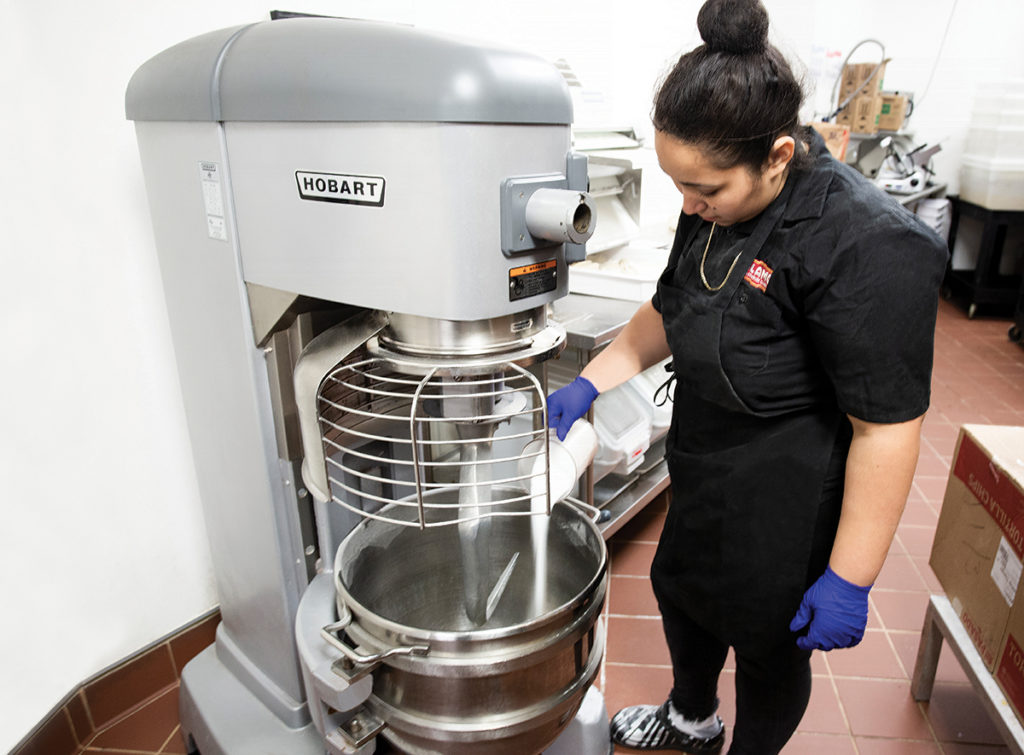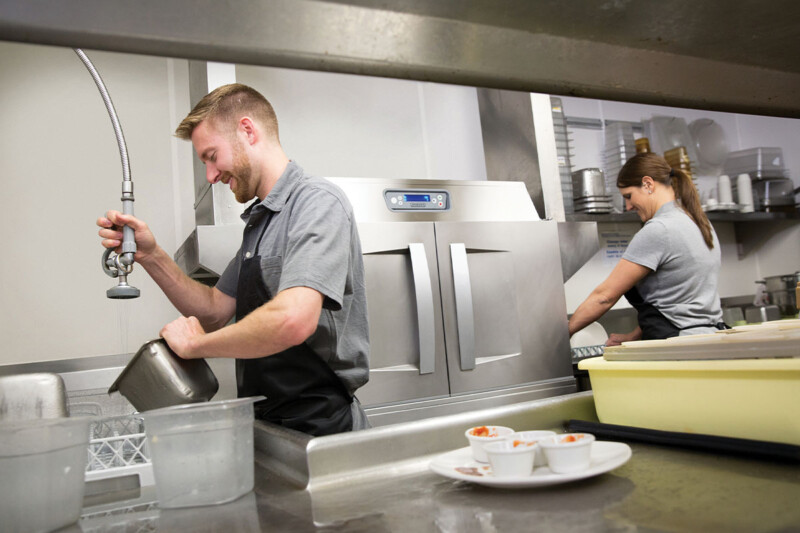Mixer Mania: 60-Qt. Floor Mixers

If your pizza business is booming, one of your most valuable players in the kitchen is without a doubt your floor mixer, which makes an average of 5,000 lb. Of pizza dough each and every week.
Designed to mix multiple ingredients quickly and efficiently, a floor mixer is a big piece of equipment and a sizable investment for your foodservice business. Along with pizzerias, large bakeries and other high-volume operations will find them indispensable as they can mix upward of 70 lb. Of thick pizza dough; 90 lb. Of bread dough; 40 lb. Of mashed potatoes; or 60 lb. Of cake or waffle batter at once. They fit nearly any application that requires high volumes of large batches of mixed ingredients. Size it right. And check out power and speed choices along with user-friendly features before landing on a model.
Size Matters
When considering a floor mixer, consider size capacity first. Take note of your current requirements for mixing (type of dough, frequency and amount), available storage as batches are prepared and held for use, and any possible menu additions in the near future. If you choose a floor mixer that’s too small, you’ll have quite the sticky mess to clean when it overflows. You’ll also have to make more batches to produce the quantity you need, which wastes time and money. You’ll then have to clean the bowls and attachments more often, adding to labor costs. You’re also more likely to overload the machine, which can harm the motor, gears and attachments, ultimately leading to costly repairs and downtime. On the flip side, choose a floor mixer that is way too large for your needs, and you’ll have spent a lot of extra money on capacity you just won’t use.
Many pizzerias and large bakeries find that a 60-qt. Capacity is right-sized for their operation. Note that the 60-qt. Capacity doesn’t mean you get 60 qt. Of dough; ingredients should not be filled higher than the functional part of the agitator or you won’t get a proper mix.
Furthermore, some dough types vary widely in how much they expand, so manufacturers suggest operators know their dough’s absorption ratio (the water weight divided by the flour weight) and then refer to the manufacturer’s capacity chart—a very key guide. When mixing any dough with an absorption rate lower than what’s listed by the mixer manufacturer for your model, decrease the batch size proportionately to make sure the dough is mixing properly and won’t overflow the bowl. Some 60-qt. Floor mixer models accept a step-down (30- or 40-qt.) Bowl for smaller batches, while some operations buy a separate smaller mixer to produce the quantities they need for things such as icings, sauces and fillings.
Say You Want A Revolution?
Choosing the appropriate capacity for your floor mixer is only the first step as there are a number of ways 60-qt. Models differ from each other. The revolution of the mixer is one. There are planetary-style mixers, which feature an agitator that circles the perimeter of the bowl on an offset shaft or arm while the bowl remains stationary, and there are spiral-style mixers, which have a spiral-shaped agitator that rotates in place while the bowl rotates around it.
Planetary mixers are more versatile and can mix anything from dough to sauces to batters to whipped toppings. They also can accommodate a number of different attachments for other kitchen functions (see Dealer Focus, page 41) . Meanwhile, users rely on spiral mixers mainly just for dough, kneading only a portion of the dough at one time, which gently develops the gluten structure without overworking the dough. Their sole attachment is the spiral dough hook.
Power, Drive And Speed
Models of 60-qt. Floor mixers also vary by type of transmission, in which the motor’s horsepower (usually 2 hp to 4 hp) is delivered to the bowl and permits variable speeds. In belt/pulley transmissions, users can adjust the speed on the fly with an infinitely variable range of speed options. While replacement costs are relatively inexpensive, belts may wear out quicker than other transmission types, and can slip and stretch under extremely heavy loads.
The most common kind of transmission in 60-qt. Floor mixers is gear-driven, which can deliver more torque to power through denser recipes, offers greater efficiency, and delivers dependable mixing velocity and consistent products. On the downside, gear-driven mixers are often noisier, more expensive to repair, and users have to bring them to a complete stop before changing speeds.
Recently, however, a variable frequency drive (or similar, variable speed drive) is available that eliminates the need for separate sets of gears for each motor speed. This means users don’t need to stop the unit to mix faster or slower. Equipping gear-driven models with variable frequency drive also means that these mixers can accelerate slowly with a “soft start,” minimizing the ingredient splash you sometimes get starting these units up.
Typically, 60-qt. Floor mixers offer three mixing speeds that range from 40 to 250 rpm that satisfy the variable requirement of most recipes. Mixing dough usually calls for a lower speed while batters, whipped toppings and meringues need higher speeds to incorporate air into the mix. Some models also include overdrive speeds—over 300 rpm—while others include a stir speed, an optimal rpm to add ingredients with minimal splash-out.
Ease Of Use
Another feature to look for is whether the mixer has a bowl lock that prevents employees from operating it unless the bowl is seated properly. Bowl guards with built-in ingredient chutes expedite adding ingredients because you don’t have to stop the machine and remove the guard. Models also can include digital or mechanical timers that display how much time is left in a batch currently in progress. Users tend to prefer the accuracy of a digital display that is easy to see on the front of the unit vs. on the side.
Using a 60-qt. Floor mixer also means you’ll be producing some pretty heavy batches of dough. Consider whether the mixer model includes a manual or power bowl lift (which requires a secondary motor) and if a bowl truck comes standard to assist users in transporting the batch to another part of the kitchen. To that end, make sure there is ample floor space around the mixer for swing bowls and bowl trucks.
Mistakes To Avoid
Manufacturers report that three-speed-motor floor mixers have a 50/50 chance of being hooked up correctly when connected to a power source. They recommend having a qualified technician or electrician double-check that the motor is turning in the correct direction of the operation (most units have an arrow to indicate the correct direction). Once discovered, this common problem is easily fixed by switching two wires in the panel or on the mixer. To comply with local codes and OSHA regulations, a commercial floor mixer should also be listed against NSF Std. 8 and UL763 (US) and CSA22.2 No 195 (Canada) by a nationally recognized test laboratory.
Finally, manufacturers recommend knowing the exact details of the model’s warranty and to consider the life-cycle cost when researching a 60-qt. Floor mixer. Find out how long the warranty is, whether both labor and parts are covered, and then the cost of repairing or replacing parts after the warranty has expired. You won’t want your most valuable player to be benched for too long: it takes dough to make dough.
Click to the next page to view the Mixer Gallery.
RELATED CONTENT
- Advertisement -
- Advertisement -
- Advertisement -
TRENDING NOW
- Advertisement -
- Advertisement -
- Advertisement -


